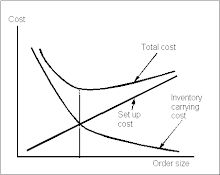http://www.bizjournals.com/birmingham/stories/2008/10/13/daily1.html?surround=lfn&brthrs=1
This article describes the recent decision by Honda to start producing their Honda Accord in their Alabama manufacturing plant. According to the article, this decision has adjusted the overall production mix for the Alabama plant, which means their other "Alabama" vehicles will now be produced in smaller quantities (the Honda Pilot and the Honda Odyssey).
I thought this article was interesting because it can relate to some of the materials in our OM 523 class, specifically the Economic Production Quantities. Production managers at Honda must be keenly tuned into their demand patterns for ordering decisions, because their production rates are now changing. Therefore, in order for the company to avoid stock-out costs as well as avoid producing too many of these vehicles, their inventory managers must alter the EPQ calculations.
-Andrew Freeman
Subscribe to:
Post Comments (Atom)

5 comments:
Trial Comment
I would expect a model dealing with demand rate and production rate as a function of time so that the inventory control is able to respond quickly to changes at either end.
-Bing Liu
I do not know if the production managers should be given credit for being "keenly tuned into their demand". Honda, as well as all other Auto Manufacturers has a target inventory level for its vehicles. If I remember correctly from division meeting presentations Honda's is 45 to 60 days of inventory. Since the increase in fuel prices light truck sales for the US has been dropping significantly. Honda had no choice but to lower the production of the Odyssey and Pilot. As a result Honda Mfg. of Alabama was going to have extra capacity, while the Civic has been unable to meet demand. So the Ridgline is moved from Canada to Alabama, and Canada can build more Civics. Since the Ridgeline does not provide much relief, Honda looks again for another vehicle. Initially another product from Canada, the Acura MDX was going to move, but the decision to make the Accord, was probably made to allow for better flexibility in Alabama (being able to build vehicles other than light trucks), while allowing an immediate increase in either additional Civic or V-4 Accord production in Ohio. However, EPQ, I believe, has nothing to do with it. American Honda is the company that orders vehicles from the Honda plants in the US which run for two shifts. Vehicles are run in lots of thirty. I am not sure, but I imagine EPQ was never a consideration. If sales drop, American Honda orders less vehicles and the plants build to those orders.
The credit to Honda is how quickly production will move. But the inventory levels for the vehicles have been high since June. Another credit to Honda is that their inventories are much less than other manufacturers.
I believe that this article is a great example of several key ideas from our OM 523 class. With the shift of the V6 Accord to the Lincoln plant, comes along a new challenge for Honda. Since they are cutting production of the other two vehicles, they are going to have to shift what kind of inventory that they will have to carry. They may have to match up with new suppliers that can supply the Lincoln plant with the right inventory. Overall, managers at Honda will have to spend time planning for this change over if they want to remain competitive on price in the automotive industry.
Wow!! I am impressed with the level of discussion going on for this post.
Good job Andrew for starting such a discussion!
Thank you all the contributors!
Post a Comment